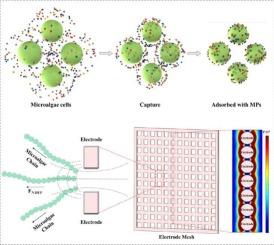Effective removal of nanoplastic and microplastic particles by using microalgae cells with dielectrophoresis-assisted method
IF 6.7
2区 工程技术
Q1 ENGINEERING, CHEMICAL
引用次数: 0
Abstract
This work presents the removal of nanoplastic and microplastic particles using microalgae cells in a dielectrophoresis-assisted system. Microalgae cell was tested against two types of particles: 500 nm polystyrene nanoplastic particles, and 1 μm polystyrene microplastic particles and silicon dioxide microspheres. The growth ratio of the microalgae was determined by quantifying the suspension against the particles. Then the microalgae chains adsorbed with particles were trapped by the dielectrophoretic effects in the vicinity of the electrode cross-corner, which was induced by applying DC electric field through the embedded electrode meshes. Accurate quantification of capture efficiency was achieved by quantifying the microalgae adsorbed with plastic particles before and after the treatment in the DEP assisted device. This study examined the effects of the concentration of microalgae cells and microplastic particles, the particles size and type on its removal, and the applied electrical potential and electrode mesh on the capture of microalgae cells adsorbed with MPs and NPs. The results suggest that the particles were successfully removed by microalgae cells which was further trapped by the DEP-assisted device with capture ratio as high as 95 %, demonstrating a promising strategy for the removal of nanoplastic and microplastic particles using microalgae cells.

微藻细胞介电泳辅助去除纳米塑料和微塑料颗粒
这项工作提出了在介电泳辅助系统中使用微藻细胞去除纳米塑料和微塑料颗粒。微藻细胞对500 nm聚苯乙烯纳米塑料颗粒、1 μm聚苯乙烯微塑料颗粒和二氧化硅微球两种颗粒进行了测试。通过对悬浮颗粒的定量测定来确定微藻的生长比。然后,通过嵌入的电极网施加直流电场,在电极交叉角附近产生介电效应,捕获被颗粒吸附的微藻链。通过对DEP辅助装置处理前后被塑料颗粒吸附的微藻进行定量,实现了捕获效率的准确量化。本研究考察了微藻细胞和微塑料颗粒的浓度、颗粒大小和类型对其去除的影响,以及外加电势和电极网对吸附了MPs和NPs的微藻细胞的捕获的影响。结果表明,微藻细胞成功去除纳米塑料和微塑料颗粒,微藻细胞的捕获率高达95%,表明利用微藻细胞去除纳米塑料和微塑料颗粒是一种很有前景的策略。
本文章由计算机程序翻译,如有差异,请以英文原文为准。
求助全文
约1分钟内获得全文
求助全文
来源期刊

Journal of water process engineering
Biochemistry, Genetics and Molecular Biology-Biotechnology
CiteScore
10.70
自引率
8.60%
发文量
846
审稿时长
24 days
期刊介绍:
The Journal of Water Process Engineering aims to publish refereed, high-quality research papers with significant novelty and impact in all areas of the engineering of water and wastewater processing . Papers on advanced and novel treatment processes and technologies are particularly welcome. The Journal considers papers in areas such as nanotechnology and biotechnology applications in water, novel oxidation and separation processes, membrane processes (except those for desalination) , catalytic processes for the removal of water contaminants, sustainable processes, water reuse and recycling, water use and wastewater minimization, integrated/hybrid technology, process modeling of water treatment and novel treatment processes. Submissions on the subject of adsorbents, including standard measurements of adsorption kinetics and equilibrium will only be considered if there is a genuine case for novelty and contribution, for example highly novel, sustainable adsorbents and their use: papers on activated carbon-type materials derived from natural matter, or surfactant-modified clays and related minerals, would not fulfil this criterion. The Journal particularly welcomes contributions involving environmentally, economically and socially sustainable technology for water treatment, including those which are energy-efficient, with minimal or no chemical consumption, and capable of water recycling and reuse that minimizes the direct disposal of wastewater to the aquatic environment. Papers that describe novel ideas for solving issues related to water quality and availability are also welcome, as are those that show the transfer of techniques from other disciplines. The Journal will consider papers dealing with processes for various water matrices including drinking water (except desalination), domestic, urban and industrial wastewaters, in addition to their residues. It is expected that the journal will be of particular relevance to chemical and process engineers working in the field. The Journal welcomes Full Text papers, Short Communications, State-of-the-Art Reviews and Letters to Editors and Case Studies
 求助内容:
求助内容: 应助结果提醒方式:
应助结果提醒方式:


